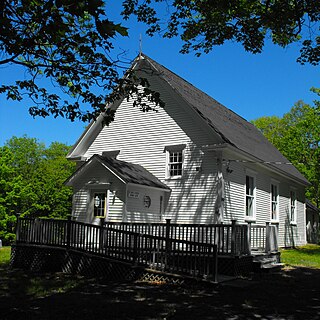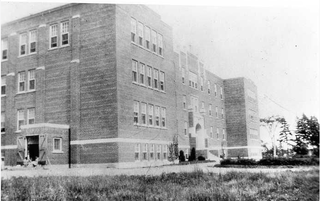
Cape Breton University (CBU), formerly known as the "University College of Cape Breton" (UCCB), is a university in the Cape Breton Regional Municipality, Nova Scotia, Canada. Located near Sydney, CBU is the only post-secondary degree-granting institution on Cape Breton Island. The university is enabled by the Cape Breton University Act passed by the Nova Scotia House of Assembly. Prior to this, CBU was enabled by the University College of Cape Breton Act (amended). The University College of Cape Breton's Coat of Arms were registered with the Canadian Heraldic Authority on May 27, 1995.

Colchester County is a county in the Canadian province of Nova Scotia. With a population of 50,585 the county is the fourth largest in Nova Scotia. Colchester County is located in north central Nova Scotia.

Kings County is a county in the Canadian province of Nova Scotia. With a population of 60,600 in the 2016 Census,, Kings County is the third most populous county in the province. It is located in central Nova Scotia on the shore of the Bay of Fundy, with its northeastern part forming the western shore of the Minas Basin.

Truro is a town in central Nova Scotia, Canada. Truro is the shire town of Colchester County and is located on the south side of the Salmon River floodplain, close to the river's mouth at the eastern end of Cobequid Bay.

Mahone Bay is a town on the northwest shore of Mahone Bay along the South Shore of Nova Scotia in Lunenburg County. A long standing picturesque tourism destination, the town has recently enjoyed a growing reputation as a haven for entrepreneurs and business startups. The town has the fastest growing population of any municipality in Nova Scotia according to the 2016 census, experiencing 9.9% population growth.
Rita Joe, was a Mi'kmaw poet and songwriter, often referred to as the Poet Laureate of the Mi'kmaq people.

Shubenacadie is a village located in Hants County, in central Nova Scotia, Canada. As of 2006, the population was 2074.

Higher education in Nova Scotia refers to education provided by higher education institutions. In Canada, education is the responsibility of the provinces and there is no Canadian federal ministry governing education. Nova Scotia has a population of less than one million people, but is home to ten public universities and the Nova Scotia Community College, which offers programs at 13 locations.

Bear River First Nation is a Míkmaq First Nations band government located in both Annapolis County and Digby County, Nova Scotia. As of 2012, the Mi'kmaq population is 103 on-Reserve, and approximately 211 off-Reserve.

The Sipekne'katik First Nation is composed of four Mi'kmaq First Nation reserves located in central Nova Scotia. As of 2012, the Mi'kmaq population is 1,195 on-Reserve, and approximately 1,190 off-Reserve. The First Nation includes Indian Brook 14, Nova Scotia, near Shubenacadie, Nova Scotia. The band was known as the Shubenacadie First Nation until 2014 when the traditional spelling and pronunciation of its name was officially adopted.

Treaty Day is celebrated by Nova Scotians annually on October 1 in recognition of the Treaties signed between the British Empire and the Mi'kmaq people. The first treaty was signed in 1725 after Father Rale's War. The final Halifax Treaties of 1760-61, marked the end of 75 years of regular warfare between the Mi'kmaq and the British. The treaty making process of 1760-61, ended with the Halifax Treaties (1760-1761).

The Grand Council is the normal senior level of government for the Mi’kmaq, based in present-day Canada, until passage of the Indian Act in 1876, requiring elected governments. After the Indian Act, the Grand Council adopted a more spiritual function. The Grand Council was made up of representatives from the seven district councils in Mi'kma'ki. The Grand Council was composed of Keptinaq, or captains in English, who were the district chiefs. There were also Elders, the Putús, the women's council, and the Grand Chief.

Gabriel Sylliboy was the first Mi'kmaq elected as Grand Chief (1919) and the first to fight for the recognition by the state of Canada of the treaties between the government and the First Nations people.
Ursula Johnson is a multidisciplinary Mi’kmaq artist based in Halifax, Nova Scotia, Canada. Her work combines the Mi’kmaq tradition of basket weaving with sculpture, installation, and performance art. In all its manifestations her work operates as didactic intervention, seeking to both confront and educate her viewers about issues of identity, colonial history, tradition, and cultural practice. In 2017 she won the Sobey Art Award.

The Miꞌkmaq–Nova Scotia–Canada Tripartite Forum was established in 1997 to provide the Miꞌkmaq, Nova Scotia and Canada a place to resolve issues of mutual concern. The Forum's vision is to develop Mi'kmaw communities and foster positive relationships with other Nova Scotians.

The Shubenacadie Indian Residential School was part of the Canadian Indian residential school system and was located in Shubenacadie, Nova Scotia. It was the only one in Atlantic Canada and children from across the region were placed in the institution. The schools were funded through Indian Affairs and the Catholic Church. The institution was like an orphanage, which were the forerunners of contemporary child protection and welfare services. The first children arrived on February 5, 1930 and the institution was closed after 37 years on June 22, 1967. Approximately 10% of Mi'kmaq children lived at the institution. Over 1000 children are estimated to have been placed in the institution over 37 years.
Jaime Battiste is a Mi’kmaq writer, researcher, historian and activist from Potlotek First Nation. A published author and researcher of Mi'kmaq law, he has worked on numerous boards for Mi'kmaq advancement, served on the National Executive Council of the Assembly of First Nations, taught as an assistant professor of Mi’kmaq Studies at Cape Breton University, and worked as legal adviser to the Mi’kmaq Grand Council. Battiste has published law review articles about Mi’kmaq law and Aboriginal and treaty rights. In 2004, he was honored as a National Role Model by the National Aboriginal Health Organization. In 2012, he was under contract with the Mi’kmaq Rights Initiative as a Citizenship Officer. He is currently a citizenship coordinator for the Mi'kmaq Rights Initiative.
Marie Ann Battiste is an author and educator working as a professor at the University of Saskatchewan in the Department of Educational Foundations. From the Potlotek First Nation In Nova Scotia, Battiste is the daughter of Mi'kmaq parents John and Annie Battiste and is one of four children. Battiste was raised in Houlton, Maine, where she attended high school graduating in 1967. Form there she went on to the University of Maine graduating from the Farmington campus in 1971 with her teaching certificate and a bachelor of science in both elementary and junior high education. She went on to attend Harvard University graduating in 1974 with a master of education in administration and social policy as well as Stanford University, where in 1984 she graduated with a doctor of education in curriculum and teacher education.

Halifax Treaties were 11 written documents signed by the various bands of the Mi’kmaq and the British in Halifax, Nova Scotia between 1760 and 1761. The Treaties ended the conflict that had persisted between the two peoples for 85 years. The Treaties include both military submissions, or oaths of allegiance made at the three fortresses in the region followed by treaties signed at Halifax, as well as the oral promises made during Treaty ceremonies to guarantee the Mi'kmaq the protection and rights as British subjects. The ceremony with the most primary sources was the Burying the Hatchet ceremony, which happened on 25 June 1761. While most historians have concluded that the language of the Treaties clearly reflect that the Mi'kmaq surrender to the British, other historians have suggested otherwise.
Benjamin Kji Saqamaw Sylliboy was a Grand Chiefs of the Miꞌkmaq who lived at the We’koqma’q first nation in Cape Breton, Nova Scotia, Canada. He served as Grand Chief for 25 years from 1992 until his death in 2017.















